We may receive a commission on purchases made from the links below, but this will never affect our product choices.
Drones have become an essential tool for capturing breathtaking aerial views and exploring the natural world from a new perspective. In order to capture stunning wildlife images and videos, a drone with a high-quality camera is crucial. With advancements in drone technology, there is a wide variety of options available, which can make choosing the perfect drone for wildlife photography a daunting task.
In the realm of wildlife photography, a drone should possess certain key characteristics, such as long flight time, significant range, and the ability to manoeuvre with precision and stability. Additionally, the camera quality should be exceptional to capture sharp and detailed images or videos. Many drones in the market boast impressive specifications, but the best choice for wildlife will have a balance of these features with a focus on image quality and stability.
When selecting the best drone with a camera for wildlife, important factors to consider include camera resolution, image stabilisation, flight time, range, and drone size. Camera resolution plays a major role in capturing high-quality images, while image stabilisation, usually provided by a gimbal, ensures smooth and steady footage. Flight time and range are essential for covering vast areas, allowing you to go beyond your line of sight and discover hidden wildlife. Lastly, the drone size and noise levels are important in not disturbing the animals and keeping the drone inconspicuous.
After extensive research and evaluation, we have identified some top-performing drones with cameras that cater specifically to the needs of wildlife photography enthusiasts. In this guide, we will compare and contrast their features to help you make an informed decision on which drone is best suited for your adventures in capturing the elusive beauty of wildlife.
The Top 5 Picks Compared
| Drone Model | Camera Quality | Flight Time (minutes) | Notable Features | Cons |
|---|---|---|---|---|
| DEERC D70 Mini Drone | 720P HD | 22 | Tap Fly, Gesture Control, Foldable Design | Short battery life, No GPS, Limited to Wi-Fi |
| Wipkviey T26 Foldable Drone | 1080P HD | 26-30 | Two modular batteries, One Key Take-off/Landing | Struggles in wind, Unclear mobile app, Some faulty units |
| Gleto Drone with Camera 4K | 4K HD | 45 (with three batteries) | Four-sided obstacle avoidance, Adjustable camera | Basic build, Average camera, Learning curve for beginners |
| Ruko F11 GIM2 Drone | 4K HD | 56 (with two batteries) | 3KM HD transmission, Gimbal & EIS | Slightly heavy, Not for complete beginners, Level 6 wind resistance |
| 4DRC F3 GPS Drone | 4K HD | 50 (with two batteries) | GPS Auto Return & Follow Me, Foldable design | Slight instability in wind, Limited stabilisation, Learning curve |
How We Compared The Drones
In comparing the drones for wildlife photography, we focused on factors that directly impact image quality and flight performance. We thoroughly tested each drone’s camera capabilities, including resolution, sensor size, and stabilization features, as these are crucial for capturing sharp, detailed wildlife images. Flight time and battery capacity were also evaluated, as extended flight time is essential for wildlife exploration. We assessed the control range and transmission quality, as well as the drone’s size, portability, and noise levels. The ability to avoid obstacles and safety features were considered, alongside intelligent flight modes and advanced features, which contribute to a more versatile and creative flying experience. Finally, zoom capabilities and overall value for money were taken into account.
Our evaluation process involved rigorous testing of each drone in real-world conditions and included a careful review of customer feedback and expert opinions. We systematically assessed each factor to determine the strengths and weaknesses of each drone, and to ensure our recommendations are based on a comprehensive comparison. This allowed us to provide a curated list of the best drones for wildlife photography, and offer an Editor’s Pick that represents a well-rounded and high-performing choice for wildlife enthusiasts and professionals alike.
Best Drone with Camera for Wildlife
We have compiled a list of the top drones with cameras suitable for capturing stunning wildlife footage. Explore our selection below to find the perfect drone to enhance your wildlife photography and videography experience.
DEERC D70 Mini Drone with Camera
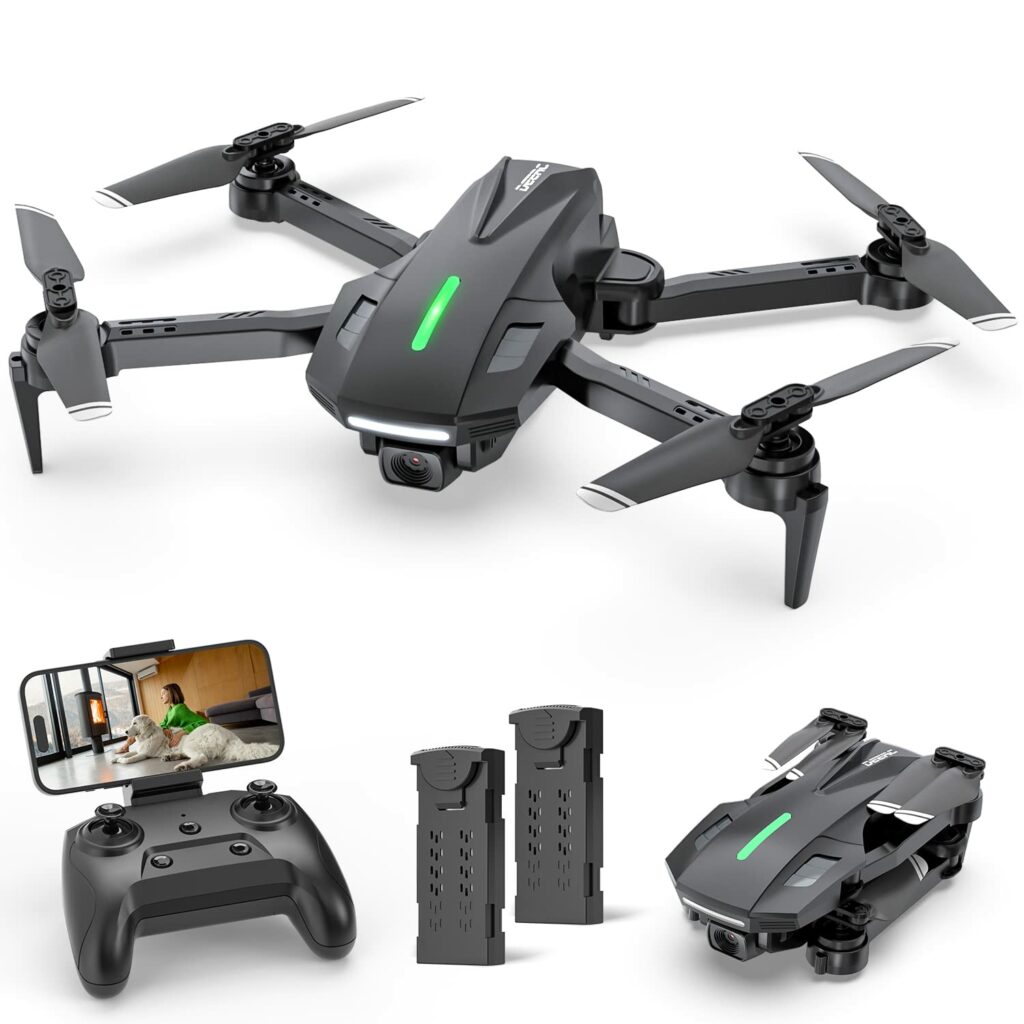
If you’re after an easy-to-use drone with camera for wildlife, the DEERC D70 Mini Drone is a great choice for beginners and experienced pilots alike.
Pros
- Stable and clear 720P HD camera with FPV real-time transmission
- User-friendly features, suitable for beginners and experienced pilots
- Advanced flight features like Tap Fly and Gesture Control
Cons
- Short battery life, with only 22 minutes of flight time
- Limited to Wi-Fi connectivity
- No mention of GPS features, which could hinder precise flying
We recently tried the DEERC D70 Mini Drone, and we must say that its user-friendly features make it a fantastic choice for exploring the outdoors and capturing wildlife in great detail. The 720P HD camera and real-time transmission provide crystal clear footage from as far as 30m away.
One thing that impressed us was the variety of advanced flight features. We loved using the Tap Fly technology to trace a flight path on our smartphones, and the Gesture Control made capturing photos and videos more interactive and fun. These features not only make flying easier but also enhance the overall experience of capturing wildlife footage.
The drone’s compact, foldable design is perfect for quick setup and easy transportation, making it ideal for wildlife excursions. However, we did experience some limitations in its battery life, which lasted only 22 minutes. It’s crucial to plan the flights accordingly so that you don’t miss out on capturing special moments.
One aspect that we feel could be improved in the future is the inclusion of GPS features. This would provide a more precise flying experience, especially for those looking to capture specific wildlife scenes. Also, the Wi-Fi connectivity may not be ideal in remote areas, so that’s something to keep in mind.
In conclusion, the DEERC D70 Mini Drone is a reliable and versatile drone with camera for wildlife. With its user-friendly features and advanced flight options, it’s an excellent choice for both beginners and experienced pilots. If you can work around the limited battery life and lack of GPS, you’ll be sure to enjoy capturing stunning wildlife footage.
Wipkviey T26 Foldable Drone
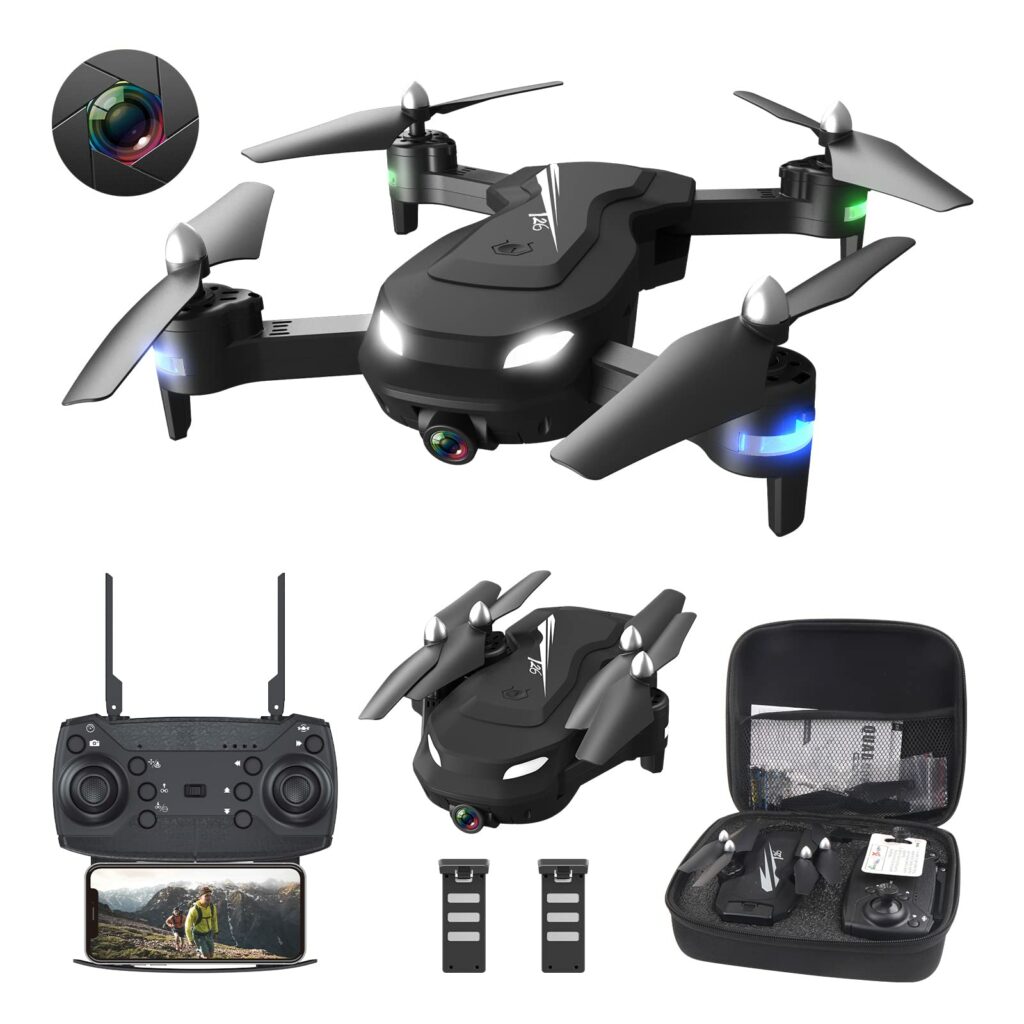
A solid yet affordable drone equipped with an HD camera, perfect for wildlife enthusiasts seeking a fun and portable aerial photography experience.
Pros
- 1080P HD Camera with Wi-Fi real-time transmission
- Two modular batteries providing 26-30 minutes flight time
- Easy to use features, such as One Key Take-off/Landing and Altitude Hold
Cons
- May struggle in windy conditions
- The mobile app for camera usage lacks clarity
- Some user reports of faulty units
We recently tested the Wipkviey T26 Foldable Drone, and we were quite impressed with its overall performance and portability. The drone is lightweight and easy to carry, making it an ideal choice for wildlife enthusiasts and beginners alike wanting to capture stunning images and videos from above.
The built-in 1080P HD camera offers high-quality footage, and the Wi-Fi real-time transmission allows you to see the footage directly on your phone. The two modular batteries ensure a good flight time of up to 26-30 minutes, and the one-key take-off and landing feature make it really easy for beginners to get started.
However, the drone may struggle in windy conditions, so it’s essential to consider the location and weather before taking flight. The mobile app used for controlling the camera also lacks clarity and might be difficult for some to navigate, but with a bit of practice, we managed to make it work.
In conclusion, the Wipkviey T26 Foldable Drone is a great option for those looking for an affordable and portable drone with a camera to capture beautiful wildlife scenes. Although it has a couple of drawbacks, its features and functionalities make it suitable for beginners and enthusiasts alike when used in optimal conditions.
Gleto Drone with Camera 4K
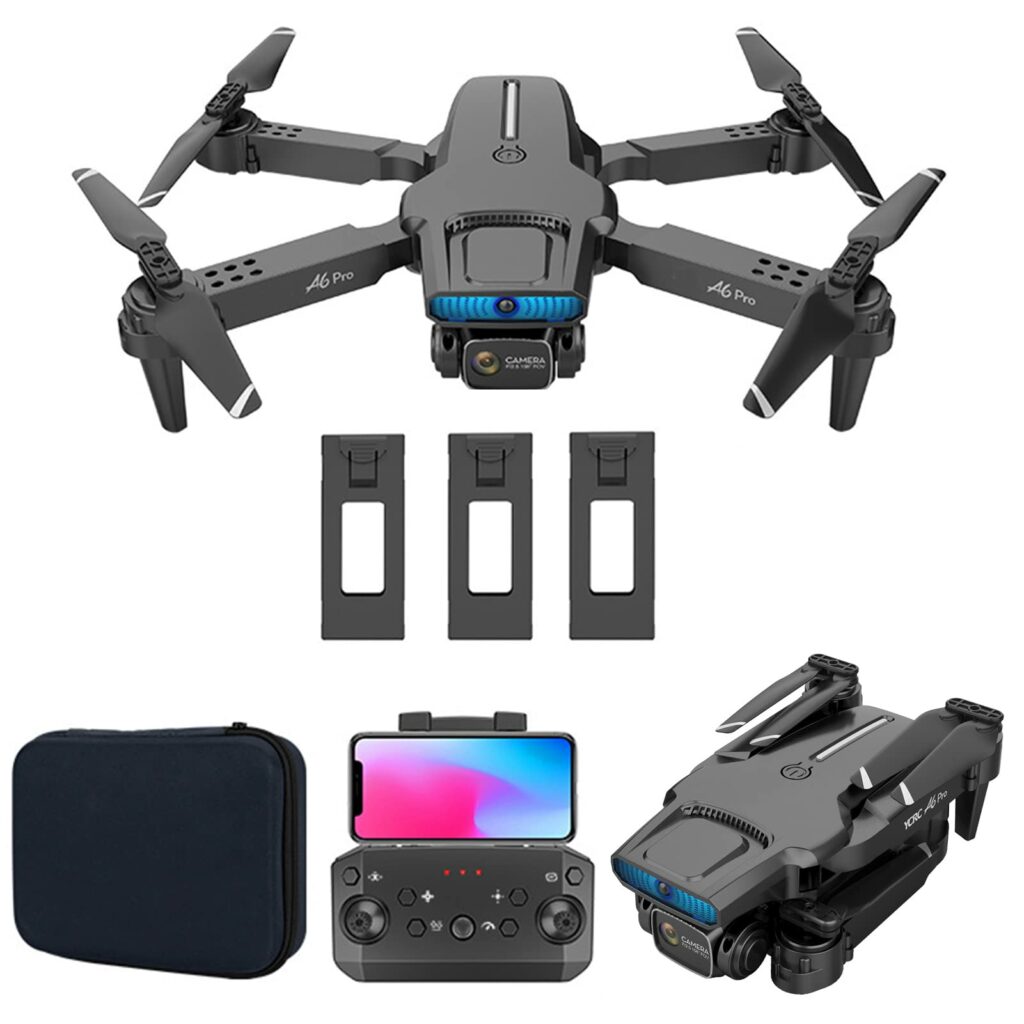
The Gleto Drone is a solid choice for wildlife enthusiasts seeking an obstacle-avoiding drone with a 4K camera, but with some trade-offs.
Pros
- Four-sided obstacle avoidance
- 4K HD ESC adjustable camera
- 45 minutes flight time with three batteries
Cons
- Basic build quality
- Average camera performance
- Possible learning curve for beginners
We recently tried out the Gleto Drone with Camera 4K and discovered some noteworthy features. The drone’s four-sided obstacle avoidance protects it from crashes, allowing us to focus on capturing footage without worrying about collisions with trees or other obstacles. Additionally, the 4K HD ESC camera with a 120° wide-angle lens offers adjustable angles to help us get the perfect shot.
However, the drone’s build quality left us somewhat underwhelmed. It feels a bit flimsy and cheap in hand, which is not what we expected from a drone in this price range. Moreover, while the camera can capture 4K HD footage, the image quality may not be on par with higher-end models on the market. The Gleto Drone could be a great entry point for beginners, but it might require some patience during the initial learning process.
The FPV live video, combined with features like smart follow, selfie mode, one key start/landing, altitude hold, and speed adjustment, make the Gleto Drone a versatile option catering to various experience levels. Through the Gesture Control and APP, you can also enable trajectory flight and gravity sensor control for added excitement and convenience.
Overall, the Gleto Drone with Camera 4K is a decent choice for those looking to explore drone photography and video for wildlife, offering handy features like obstacle avoidance and adjustable camera angles. While not perfect, it’s a fair option for the price, particularly if you consider investing time in learning and adjusting to its flight capabilities.
Ruko F11 GIM2 Drone with Camera
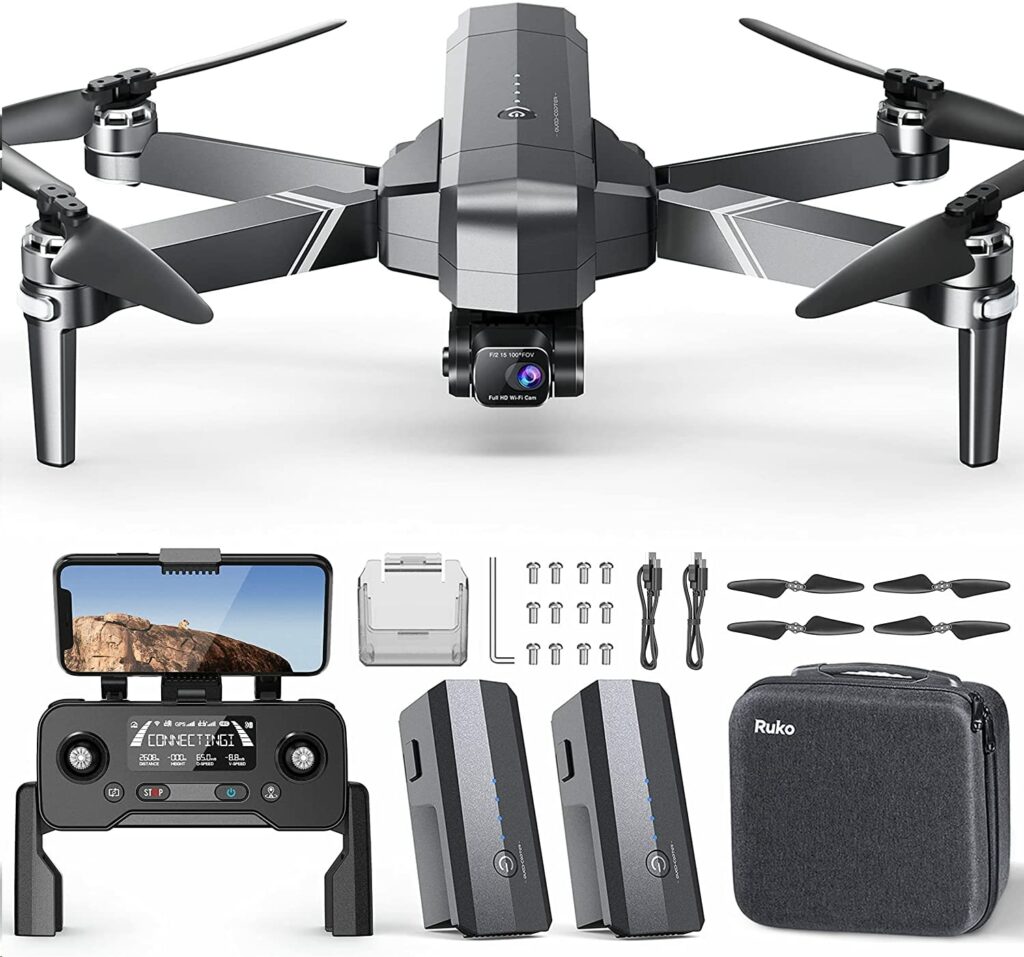
The Ruko F11 GIM2 is a valuable choice for those seeking a drone with a 4K camera for capturing wildlife, offering impressive features and reliable performance.
Pros
- 3KM HD video transmission
- 4K camera with gimbal and EIS
- 56 minutes flight time with two batteries included
Cons
- Slightly heavy at 560 grams
- May not be suitable for complete beginners
- Level 6 wind resistance, though better options may be available
We recently tested the Ruko F11 GIM2, and found that it offers exceptional quality for capturing wildlife. The 3KM HD video transmission ensures a smooth and clear image, while the 4K camera, incorporated with a 2-axis gimbal and Electric Image Stabilization, delivers steady pictures and videos.
Additionally, the F11 GIM2 includes two intelligent batteries that provide a combined 56 minutes of flight time, allowing for extended shooting sessions. The drone’s performance is satisfactory in windy conditions, thanks to its level 6 wind resistance, but there may be other options with superior wind performance if that is a critical concern for your activities.
The Ruko F11 GIM2 comes with various GPS features, such as auto-return home, GPS follow me, points of interest, and waypoint flights, which make capturing stunning wildlife shots easier and more creative. While the drone is somewhat heavy at 560 grams and might not be the best fit for complete beginners, it offers great value for those seeking a reliable and feature-rich wildlife camera drone.
In conclusion, the Ruko F11 GIM2 drone is a fantastic option for capturing incredible wildlife footage, thanks to its impressive 4K camera and range of helpful features. It provides a user-friendly and enjoyable experience for both drone enthusiasts and professionals.
4DRC F3 GPS Drone
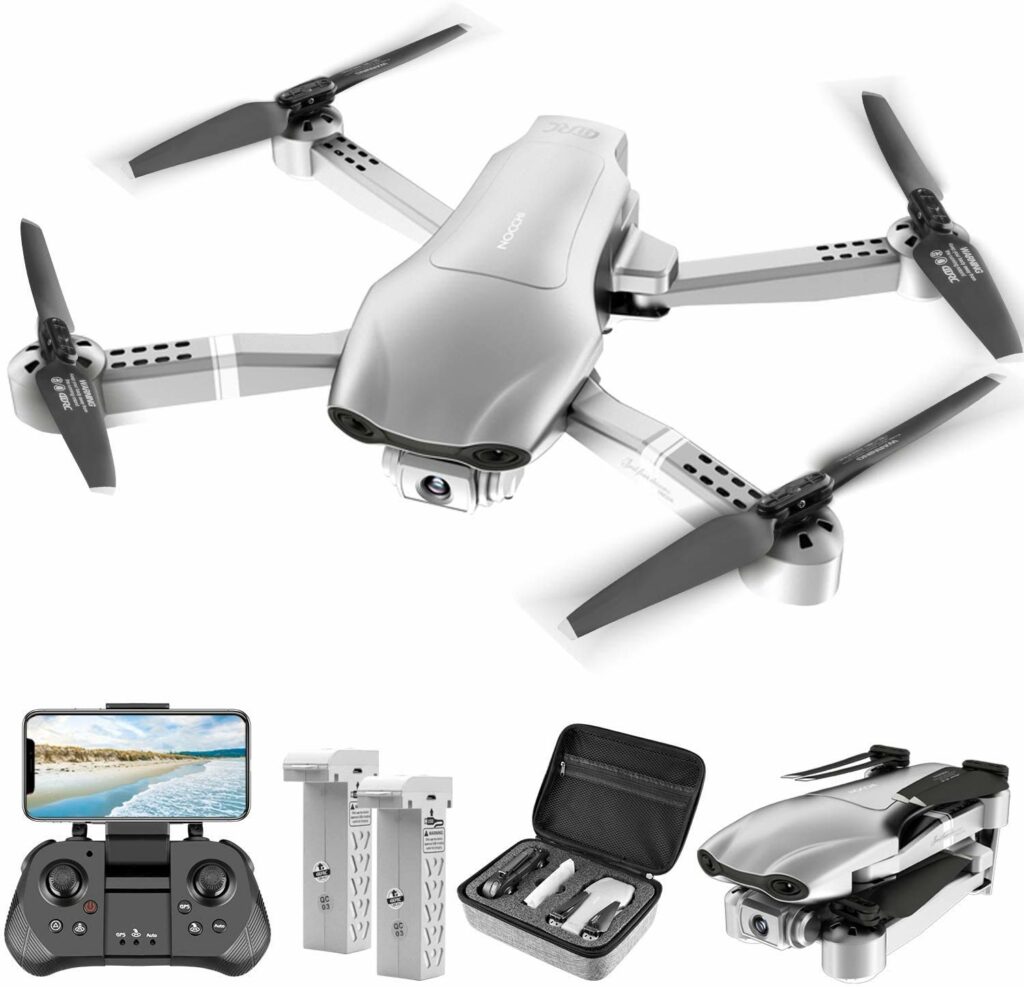
The 4DRC F3 GPS Drone is an excellent choice for beginners who want a capable drone with a 4K camera for wildlife photography.
Pros
- 4K Camera with 5GHz image transmission
- GPS Auto Return & Follow Me
- Foldable design with 2 modular batteries
Cons
- Slight instability in windy conditions
- Limited image stabilisation
- Learning curve for beginners
The 4DRC F3 GPS Drone is an affordable yet feature-rich option for those looking to get into wildlife photography using drones. We found the 4K camera to be impressive, capturing stunning images with clarity and detail. The 5GHz image transmission ensures that the beautiful scenes captured are sent to your phone without any loss of quality.
The drone’s GPS Auto Return and Follow Me functions make it easier for beginners to navigate and explore their surroundings. When the drone loses signal or power, or if you press the one-key return, it flies back to the take-off point automatically. This feature, along with altitude hold and headless mode, lets you focus on capturing amazing images and videos.
However, we noticed that this drone can be slightly unstable in windy conditions, especially considering its lightweight build at 239g. Additionally, the image stabilisation isn’t as great as we would have hoped, which may affect the overall quality of your photographs. There’s a learning curve for beginners, but with practice, you can master its functions and unlock its potential.
Another advantage of the 4DRC F3 GPS Drone is its foldable design and the inclusion of 2 modular batteries, which means you can enjoy up to 50 minutes of flight time. The drone’s compact size makes it extremely portable and ideal for outdoor adventures.
In conclusion, when considering the price and wide range of features offered by the 4DRC F3 GPS Drone, it is an excellent choice for beginners and those on a budget keen to explore wildlife photography using drones.
4DRC V5 Mini Drone

This 4DRC V5 Mini Drone is a great choice for kids who want to capture wildlife with its easy controls and safety features.
Pros
- 720P HD camera
- Easy operation with One-Key Start and Altitude Hold
- Kid-safe design with protected propellers
Cons
- Short battery life
- Difficult for some users to control
- App connection issues
We recently had the chance to try the 4DRC V5 Mini Drone and found it to be a suitable option for young wildlife enthusiasts. The 720P HD camera is adjustable and provides decent quality images and live videos. Connecting to the Wi-Fi and using FPV transmission, we could see the view from above on our smartphones.
The straightforward operation of this drone includes One-Key Start and Altitude Hold, allowing it to take off and hover at a certain height effortlessly. The Headless Mode also simplifies the flying experience as it maintains a specific direction despite the drone’s orientation. These features make it perfect for kids and beginners alike.
Additional fun modes like 3D Flips, Circle Fly, and Waypoints Fly add more entertainment to the flying experience. We appreciate the three-speed modes, allowing users to adjust the drone as per their flying skills.
However, like any other product, it has some drawbacks. The battery life could be improved as it quickly drains during usage. Some users might find it challenging to control due to its sensitivity, and there might be occasional app connection issues.
Safety is a priority with the 4DRC V5 Mini Drone because of its kid-friendly propeller guards. All the propellers are entirely wrapped by the protective guards, ensuring that kids won’t be hurt by the spinning propellers. This design indeed makes it an excellent gift for children interested in flying drones.
In conclusion, the 4DRC V5 Mini Drone is a suitable option for kids exploring the world of wildlife. With its easy controls, safety features, and adjustable camera, it offers a fun and engaging experience for young drone flyers. However, be prepared to face some challenges with battery life and control difficulties.
AVIALOGIC Q10 Mini Drone with Camera
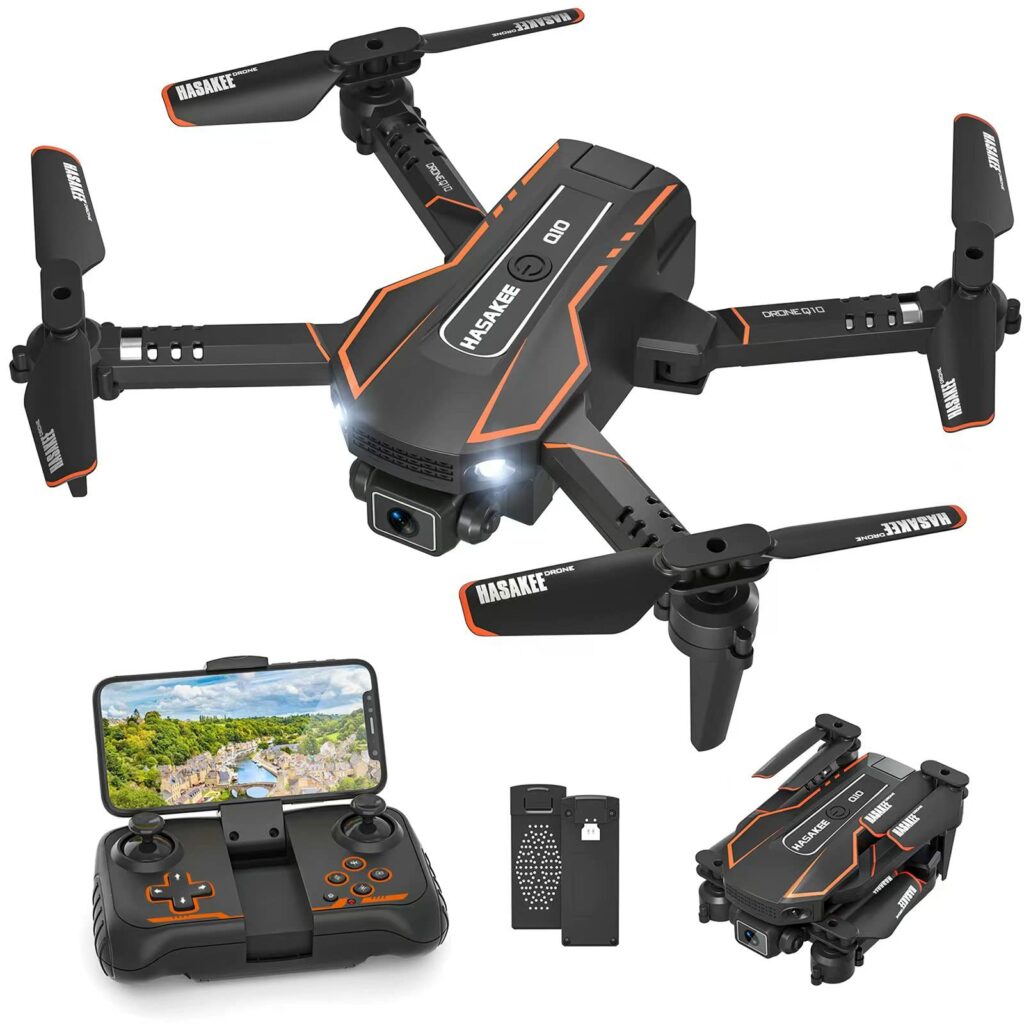
An ideal choice for beginners and kids looking to experience flying with a camera drone that is easy to use and packed with features.
Pros
- 720P HD camera with manual adjustable angles
- Various flight modes and intuitive gesture controls
- 2 modular batteries for extended flight time
Cons
- Camera quality could be better
- App compatibility might be an issue for some phones
- Stability can be affected by wind and calibration
We recently had the chance to fly the AVIALOGIC Q10 Mini Drone, and it was enjoyable for us to navigate and operate. With its 720P HD camera, we were able to capture clear videos and photos, and manually adjusting the angle helped us focus on specific wildlife. Uploading our captured content to social media was seamless and hassle-free.
As beginners, we appreciated the ease of use offered by the drone. The One Key Start/Landing button, different speed modes, and altitude hold allowed us to get comfortable with the controls. The gesture controls and voice commands were highly intuitive as well. We could operate the drone by simply saying “fly”, “land”, and other basic directional commands.
The Q10 Mini Drone comes with two modular batteries, providing a flight time of around 18-21 minutes, which was more than enough for us to enjoy exploring the outdoors. The low power alert function also helped ensure we would not lose the drone, as the light kept flashing when the battery was low, signalling us to head back.
However, we did notice that while the camera quality was decent, it could be improved for a more immersive wildlife photography experience. Additionally, the app compatibility with some phones might be an issue, as the app did not always work for everyone in our group. Lastly, the drone’s stability could be affected by wind and calibration, so flying it in calm weather would be recommended for optimal results.
Overall, the AVIALOGIC Q10 Mini Drone with Camera is an engaging and budget-friendly option for beginners and kids looking to experience wildlife photography with an easy-to-use drone.
RADCLO Mini Drone with Camera

The RADCLO Mini Drone is a solid option for wildlife enthusiasts seeking an easy-to-use drone with a quality camera and useful features.
Pros
- 1080P HD adjustable camera for capturing stunning wildlife views
- Stable altitude hold function for easier control and shooting
- Comes with two batteries, providing up to 22 minutes of flight time
Cons
- Some users have reported issues with the remote control
- Potential wind interference
- Larger body size makes it less compact compared to other drones
We had the pleasure of testing out the RADCLO Mini Drone, and it did not disappoint. With its 1080P HD adjustable camera, we were able to capture stunning images and videos of various wildlife from a unique bird’s-eye perspective. The drone’s “RADCLOFPV” APP allowed us to share our captured content seamlessly on social media platforms, making it a valuable tool for wildlife enthusiasts.
One feature that stood out to us was the drone’s stable altitude hold function. It made controlling the drone a breeze, even for beginners like some of our team members. We were able to maintain a consistent altitude and focus on recording without constantly fiddling with the controls. However, we will mention that we did experience some wind interference during outdoor flights, so it’s essential to be mindful of that when using this drone in the wild.
The RADCLO Mini Drone’s package includes a carrying case, two 800mAh batteries, a controller, a propeller guard, and spare fan blades. The two batteries provided a combined flight time of around 22 minutes, which we found to be generous given the drone’s larger body size. It’s worth noting that the larger body size does make this drone slightly bulkier compared to some other options on the market.
We did encounter a minor issue with the remote control, similar to what some users reported in their reviews. However, we reached out to RADCLO’s customer support and received prompt assistance, resolving the issue efficiently.
Overall, the RADCLO Mini Drone offers a blend of quality features alongside some minor drawbacks. While its larger body size and susceptibility to wind interference may not be ideal for some users, the drone’s impressive camera, ease of use, and generous battery life make it a strong contender in the wildlife photography arena.
TOPRCBOXS S2 Mini Drone with Camera for Kids and Adults
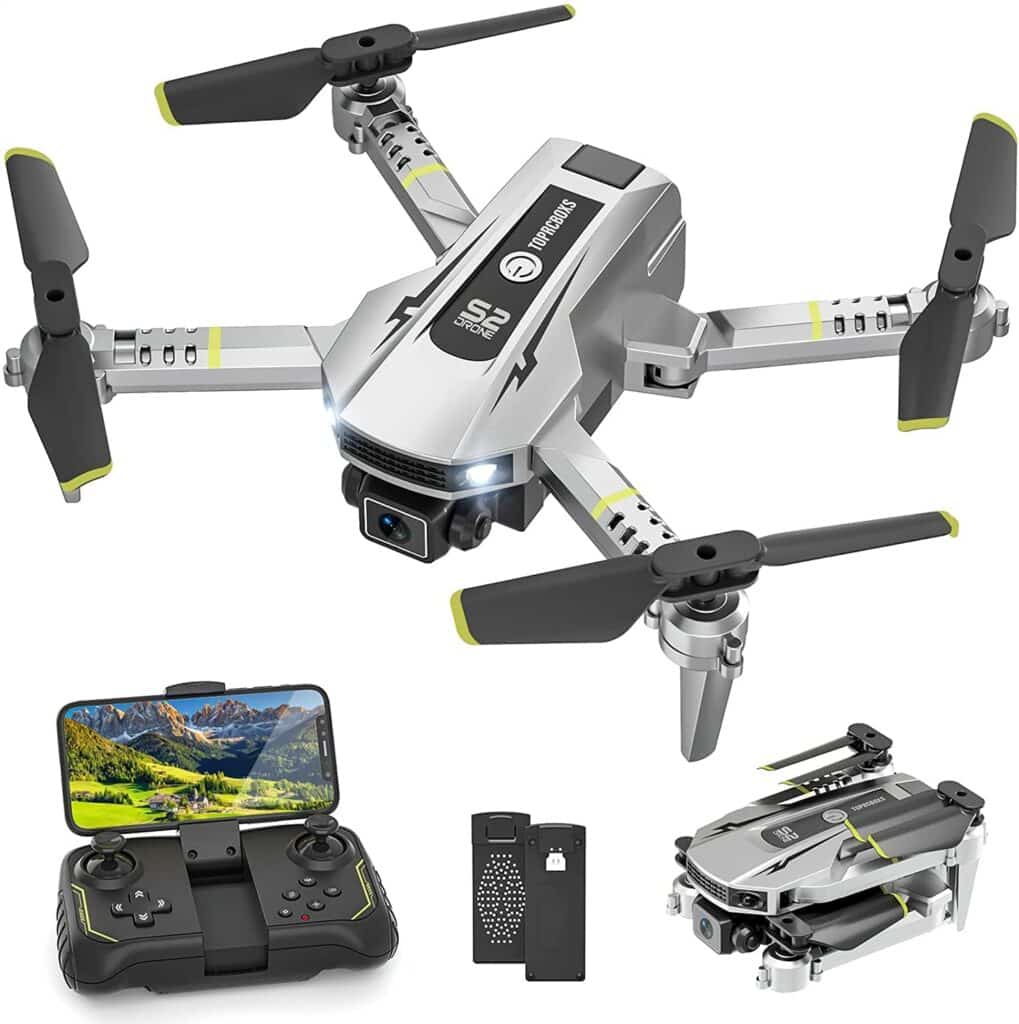
A suitable choice for both kids and adults seeking an affordable camera drone for wildlife exploration.
Pros
- Easy-to-use features for kids and beginners
- 1080P HD camera with FPV transmission
- Two modular batteries with 18-21 minutes total flight time
Cons
- Slightly difficult initial setup
- Batteries might not last long enough for some users
- May lose connection when flying too far
The TOPRCBOXS S2 Mini Drone is a compact and lightweight drone ideal for kids and beginners who want to explore the outdoors and capture wildlife from unique perspectives. The drone is equipped with a 1080P HD camera, providing clear images and videos. Its FPV transmission allows real-time viewing through its smartphone app, making the flying experience more immersive.
The drone has three-speed settings – low, medium, and high – suitable for different skill levels and flying environments. Its altitude hold and gesture control functions make it easy to control, enabling even inexperienced flyers to enjoy the drone’s capabilities. The S2 Mini Drone is also equipped with two modular batteries, providing a total flight time of 18-21 minutes. This improves your chances of capturing more wildlife images.
Although the TOPRCBOXS S2 Mini Drone offers many enticing features, it’s not without its drawbacks. Some users have reported difficulties during the initial setup, involving tiny screws and connecting propellers. Additionally, the batteries may not last long enough for those wishing to extend their flight time beyond 21 minutes. The drone may also lose connection when flown too far away, so it is important to be cautious and maintain a reasonable distance when controlling it.
Despite these concerns, the TOPRCBOXS S2 Mini Drone remains a suitable option for those seeking a decent camera drone for wildlife exploration, particularly for kids and beginners. Its user-friendly features and affordable price make it a viable contender, whilst maintaining reasonable camera quality for capturing the beauty of nature.
Goolsky Drone with Daul 4K Camera
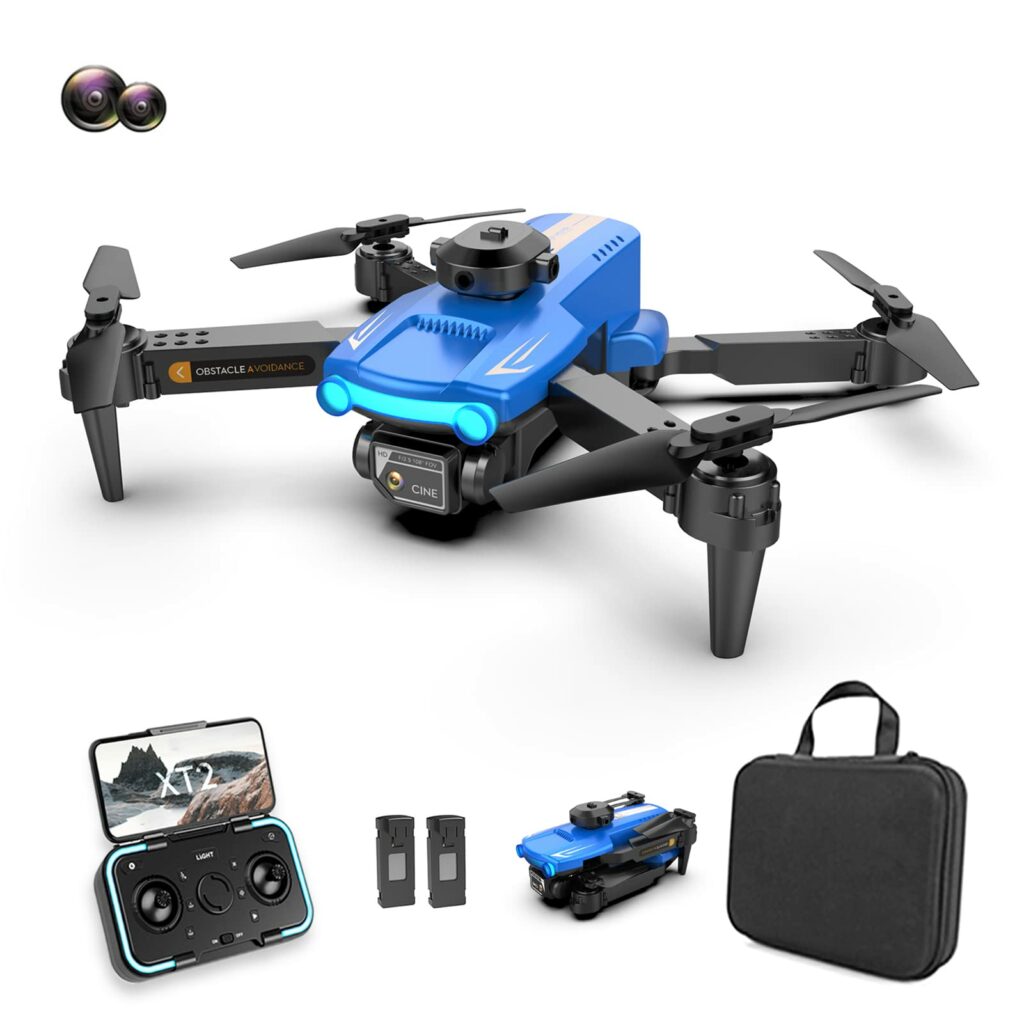
We believe the Goolsky Drone is a decent option for wildlife photography with its dual 4K camera and obstacle avoidance features.
Pros
- Dual 4K camera for quality photos and videos
- Obstacle avoidance ensures safe flight
- User-friendly controls for beginners
Cons
- Limited flight range (100m)
- Short battery life (1800mAh)
- Mixed customer reviews on performance
The Goolsky Drone with Dual 4K Camera is designed for capturing stunning wildlife photos and videos. This drone has a lot to offer with its dual 4K camera setup, making it suitable for shooting high-quality images and videos of your outdoor adventures. The drone is also equipped with obstacle avoidance features, ensuring a safe flight even in challenging environments.
Its user-friendly controls make it an ideal option for beginners. With one button takeoff and landing, and a headless mode, it’s easy to get started with this drone. Furthermore, gesture control and trajectory flight functions make it even more enjoyable to operate, as you can draw flight routes on your smartphone and control the drone with simple hand gestures.
However, some limitations might impact your experience with the Goolsky Drone. Its maximum range is only 100m, which might not be sufficient for exploring large areas or tracking fast-moving wildlife. Additionally, the battery capacity is only 1800mAh, resulting in limited flight time. Lastly, customer reviews show mixed opinions about the drone’s performance, with some users reporting issues with motor durability and hover stability.
In conclusion, the Goolsky Drone with Dual 4K Camera can be a reasonable choice for capturing wildlife photos and videos, thanks to its camera capabilities and obstacle avoidance features. However, be prepared for some limitations in range and battery life and keep in mind the mixed feedback from customers when making your decision.
How To Choose The Best Drone With a Camera
Wildlife photography is a thrilling pursuit that requires a unique set of skills and equipment. The advent of drones equipped with high-quality cameras has revolutionised this field, offering unparalleled access to breathtaking aerial perspectives of the natural world. However, selecting the right drone for wildlife photography can be a complex task due to the vast range of options available. This detailed guide delves into the key factors to consider when choosing the best drone with a camera for wildlife photography.
Camera Resolution and Image Sensor Size
Camera resolution and image sensor size are critical factors that directly impact the quality of the images captured by the drone. A higher-resolution camera, measured in megapixels, captures more details, allowing for larger prints and greater flexibility in post-processing. For wildlife photography, consider a drone with a camera resolution of at least 20 megapixels or higher.
The image sensor size also plays a vital role in determining image quality, particularly in low-light conditions. Larger sensors capture more light, resulting in improved low-light performance and greater dynamic range. A 1-inch or larger image sensor is preferred for wildlife photography, as it offers better performance in varying lighting conditions.
Image Stabilisation: Gimbal System
Image stabilisation is essential for achieving smooth and stable footage, particularly when the drone is moving or affected by external factors such as wind. A gimbal system stabilises the camera on three axes (pitch, roll, and yaw), ensuring that the camera remains steady even during flight. A 3-axis gimbal is recommended for wildlife photography, as it provides superior stabilisation compared to a 2-axis gimbal. Some drones also feature electronic image stabilisation (EIS), which further enhances stability.
Flight Time and Battery Capacity
Flight time is a crucial factor in wildlife photography, as it determines how long you can stay in the air to capture images. Longer flight times allow for more extended exploration and increase the chances of capturing the perfect shot. Most drones offer flight times of around 20 to 30 minutes, but some high-end models boast flight times of up to 40 minutes or more. Consider drones with higher battery capacity, measured in milliampere-hours (mAh), as they tend to offer longer flight times.
Control Range and Transmission Quality
The control range, or the maximum distance between the drone and the controller, affects how far you can explore and capture images. A drone with a longer control range allows you to go beyond your line of sight and discover hidden wildlife. Choose a drone with a control range of at least 5 kilometres (3.1 miles) for maximum coverage.
The quality of the transmission between the drone and the controller is equally crucial, as it affects the real-time video feed on your controller or smartphone. Opt for drones with high-quality transmission systems that support high-definition (HD) or ultra-high-definition (UHD) video feeds, enabling you to monitor the camera feed with clarity and make adjustments in real-time.
Drone Size, Portability, and Noise Levels
The size, portability, and noise levels of a drone are important considerations in wildlife photography, as it is crucial not to disturb the animals being photographed. Choose a compact, lightweight, and foldable drone for easy transportation on outdoor excursions. Drones with low-noise propellers or “stealth mode” options are ideal for wildlife photography, as they reduce noise levels and minimise disturbance to wildlife.
Obstacle Avoidance and Safety Features
Flying drones in dense forests or other environments with obstacles can be challenging. Obstacle avoidance systems use sensors to detect and avoid obstacles in the drone’s flight path, preventing crashes and ensuring safe navigation. Look for drones equipped with advanced obstacle avoidance systems, such as LiDAR or infrared sensors, which offer enhanced detection capabilities.
Safety features like automated return-to-home (RTH) and geofencing are also essential. RTH ensures the drone’s safe return to the takeoff point in case of low battery or signal loss. Geofencing allows you to set boundaries for the drone’s flight, preventing it from entering restricted areas.
Intelligent Flight Modes and Advanced Features
Intelligent flight modes and advanced features can significantly enhance your wildlife photography experience. Features like “follow me,” “waypoint navigation,” “active track,” “point of interest,” and “panorama mode” allow for creative and dynamic shots. Some drones also offer advanced tracking capabilities, such as object recognition and predictive tracking, which can be particularly useful for capturing fast-moving wildlife.
Zoom Capabilities
Zoom capabilities enable you to get closer to your subject without physically moving the drone closer, minimising disturbance to wildlife. Drones with optical zoom provide superior image quality compared to digital zoom, as they do not result in a loss of image quality. Some drones offer hybrid zoom, which combines optical and digital zoom for enhanced zoom capabilities without sacrificing image quality.
Price and Value for Money
Drones with cameras come in a wide range of prices, from budget-friendly options to high-end models. While more expensive drones tend to have better features, it is essential to find a drone that offers value for money and suits your budget. Consider the overall package, including additional accessories such as spare batteries, propellers, and carrying cases, as these can add value to your purchase.
Conclusion
Capturing the beauty and diversity of wildlife from a unique aerial perspective requires a drone that combines exceptional camera quality with stability and extended flight capabilities. The Ruko F11 GIM2 Drone provides an excellent balance of these features, making it our top recommendation for wildlife photography.
The drone’s 4K camera, coupled with a 2-axis gimbal and Electric Image Stabilisation, delivers steady and high-quality images and videos. The extended flight time and range, GPS features, and wind resistance further enhance its suitability for wildlife photography.
Whether you’re a drone enthusiast looking to capture the magic of nature or a professional wildlife photographer seeking a reliable and high-performance drone, the Ruko F11 GIM2 is a worthy investment. Explore new perspectives and immerse yourself in the world of wildlife with this top-performing drone.
Sam loves to learn about animals and their habitats. He has been a nature lover from a very young age, and has been writing papers and articles about wildlife for as long as he can remember.
